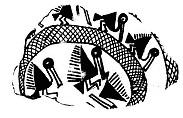Prelude 2—
The Bitter Man (Manje's Guides)

The guides said that they [Casa Grande and several other great-houses] were built by a people who came from the region of the north, their chief being El Siba, which according to their language means "the bitter or cruel man," and that through the bloody war which the Apache waged against them and the 20 tribes allied with them, killing many on both sides, they laid waste to the settlements, and part of them, discouraged, went off and returned north-ward, whence they had started years before, and the majority went east and south. (Quoted in Fewkes 1912: 55–56 )
What matters to us in both of these texts on Siba is the absence of a Pima-to-Pima conquest. Before taking up the second of the Font myths, which has a figure equivalent to the conquering Siuuhu of the later texts, I will connect the concern of Font's Siba with wind and rain to later texts from Pimas and Papagos. These form a series of variants of the same myth that Font recorded about Siba. The first in the series (ibid., 48–49), replaces Siba with a Siwañ chief at Casa Grande Ruin. The second carries the same myth into the Papago desert, with no mention of a great-house or siwañ (Saxton and Saxton 1973: 317–340). Finally are texts that replace wind and rain with corn and tobacco. All these will be given and discussed later, for the Smith-Allison mythology has versions of the final step, on corn and tobacco (part 3).
The series as a whole underscores the point made above on the Pima imagination of the Hohokam. We can see how the Siba of 1775 fits into the mythology of the later Pimas,
but we cannot know if Siba was a man who walked the Hohokam earth or if the Hohokam had a myth of a man or god like Siba. I do not regret this. If we never learn what the Hohokam thought of Siba, at least we know what we are missing. We have not lost anything, but we have gained awareness of a city that we cannot visit, the city of the Hohokams' myths.[5]
We come now to Font's second myth, which establishes a discontinuity between the eighteenth- and late nineteenth-century Pima-Papago relative to the Hohokam chiefs and the man-god who walked among them. If we were granted the opportunity to hear just one myth from the Hohokam city, I would not choose a myth on irrigation directly but on the problem of a creator god who either does or does not take vengeance on the chiefs of his people. In the discussion that follows, I will show how this god opposes the chiefs (sisiwañ ) imagined by the nineteenth-century Pimas and also the earlier character of Siba. He is an anti-rain chief but not in a way that places him in charge of rivers. Rather, he is a sun-heat god.
The second Fond myth centers on the character cognate with Smith and Allison's Siuuhu, but it gives this character a different name. The name of the Font character is "the Drinker" (El Bebedor), a well-attested variant name—actually an alternative—for Smith-Allison's Siuuhu. The Pima language for this alternative name is I'itoi, 'Drink-it-all-up'.[6] What matters from the Font myth, given below, is that the Drinker/I'itoi never dies, is never revived, and never leads a conquest against the Hohokam. In this myth he castigates people, presumably Pima-Papago and not Siba's great-house people, by turning them into saguaro cacti and by causing them to be scorched by the sun. But he never conducts a vengeful war, and he exterminates no one.